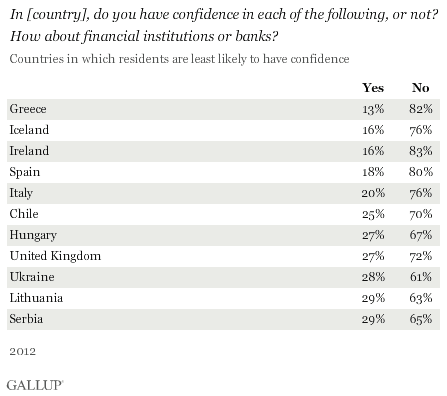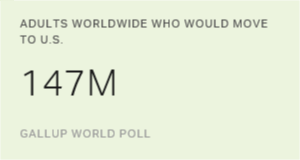WASHINGTON, D.C. -- Thirteen percent of Greeks said they had confidence in their country's banks or financial institutions in 2012, leading the nearly all-European list of countries where trust in financial institutions was among the worst in the world last year. Seven European Union countries had trust levels lower than 30%, far below the median 55% across 135 countries. Even in the EU's largest funder of the eurozone bailouts, Germany, fewer than four in 10 (38%) expressed confidence in their country's financial institutions.

Lack of confidence in financial institutions among EU member states undoubtedly results from the prolonged debt crisis afflicting the entire eurozone and the banking industry's perceived role in causing it. In several EU countries, confidence was lower in 2012 than at the height of the global financial crisis in 2008 and 2009. The ongoing crisis of confidence is also a major problem for Europe's economic recovery, as it may cause many to shun the financial services industry out of fear that their banks will fail.
Regionally, Asians Most Likely to Express Confidence in Banks
Confidence in financial institutions was regionally weakest in the EU; among the 27 EU member states, a median 37% of residents said they have confidence in their country's banks, while 55% did not. However, the trust level in the U.S. was exactly as low as the EU median, in line with the record-low levels Gallup found three years after the recession officially ended in the U.S.
In sharp contrast to Europe and the U.S., many Asian countries have weathered the global financial crisis well and emerged with considerable economic momentum. This momentum helps explain why confidence in financial institutions was highest in Asia last year -- particularly among emerging markets in Southeast and South Asia, where median trust was 77% and 75%, respectively. In Sri Lanka, Thailand, Cambodia, and Malaysia, almost nine in 10 residents expressed confidence in the financial institutions in their countries.
Confidence in East Asia did not lag far behind its southern neighbors. Median trust in the region was 66%; in China, that figure was slightly higher at 72%.

A recent report by the Asian Development Bank (ADB) forecast increased growth in the region's developing countries over the next two years, thanks to "rising private consumption and stronger intraregional trade." In particular, the ADB report highlighted rising domestic demand in Southeast Asia. For example, in Thailand, where 89% of adults said they have confidence in financial institutions, economic growth has exceeded economists' expectations since the country's devastating floods in 2011. High levels of confidence in the banks of many developing Asian countries is a good sign for the expansion of the financial services sectors, which in turn bodes well for future economic growth in these countries.
Bottom Line
U.S. President Franklin D. Roosevelt famously intoned during his first inaugural address -- when the U.S. was in the throes of its Great Depression -- "The only thing we have to fear is fear itself." That insight is no less applicable today in countries still struggling to recover from the global economic crisis. Fear kills economic activity -- whether it is a fear for physical safety that keeps people in their homes at night, or panic among financial service customers that can in extreme cases lead to devastating bank runs.
More generally, to the extent that residents are hesitant to engage with their country's financial institutions, the amount of financial capital available for economic growth is restricted. Entrepreneurs are less likely to have access to startup funds, small- and medium-sized businesses are less likely to obtain loans to expand their operations and hire more workers, and countless other economic opportunities may be stymied. For the powerful effect they can have on a country's economic health, public perceptions of financial institutions represent a vital measure for leaders seeking to promote long-term prosperity.
For complete data sets or custom research from the more than 150 countries Gallup continually surveys, please contact us.
Survey Methods
The 2012 results are based on telephone and face-to-face interviews with approximately 1,000 adults, aged 15 and older, in each of 135 countries. For results based on the total sample of national adults, one can say with 95% confidence that the maximum margin of sampling error ranged from ±2 percentage points to ±5 percentage points. The margin of error reflects the influence of data weighting. In addition to sampling error, question wording and practical difficulties in conducting surveys can introduce error or bias into the findings of public opinion polls.
For more complete methodology and specific survey dates, please review Gallup's Country Data Set details.


